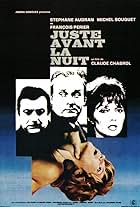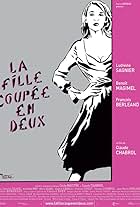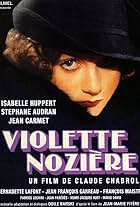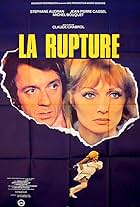IMDb RATING
6.3/10
1.1K
YOUR RATING
After separation from his wife Robert moves to Vichy where he observes beautiful Juliette. Her fiance Patrick becomes jealous and attacks Robert. When Patrick disappears Robert is suspected ... Read allAfter separation from his wife Robert moves to Vichy where he observes beautiful Juliette. Her fiance Patrick becomes jealous and attacks Robert. When Patrick disappears Robert is suspected to have killed him.After separation from his wife Robert moves to Vichy where he observes beautiful Juliette. Her fiance Patrick becomes jealous and attacks Robert. When Patrick disappears Robert is suspected to have killed him.
- Awards
- 1 win & 1 nomination
Storyline
Did you know
- TriviaOne of two adaptations of Patricia Highsmith's novel "The Cry of the Owl" that was released the same year, the other adaptation is Der Schrei der Eule (1987).
- ConnectionsVersion of Der Schrei der Eule (1987)
Featured review
I had wanted to buy this one for a long time, but repeatedly postponed it due to the excessive price-tag of the DVD and the criticism leveled at the quality of the transfer (which was decent to my eyes even on a 40" TV monitor, if somewhat dark and with the burnt-in subtitles being intrusively large and bafflingly situated towards the middle of the screen!). Anyway, I eventually took the plunge not too long ago and am extremely glad I did – what with the accompanying Audio Commentary alone proving value for money!
The film is a well-regarded effort from Chabrol's middle period, given added prestige by being adapted from the work of celebrated crime novelist Patricia Highsmith. Incidentally, it makes for an excellent example of the director's admiration for Alfred Hitchcock (who had himself brought Highsmith's STRANGERS ON A TRAIN to the screen back in 1951), building suspense and goading the audience into complicity in much the same way as the acknowledged master of the form – though the noir trappings of the narrative (and, by extension, the expressionistic quality of the cinematography here) actually derives from Fritz Lang, another strong influence.
The plot – reportedly, a very faithful rendition of the novel – seems simple enough at first: a slightly disturbed man (about to be divorced) spies on a beautiful neighbor and, when he finally confronts her, realizes that she is herself essentially unbalanced (being willing to drop her current boyfriend and take up with him!); in this regard, the film reminded me a good deal of PRETTY POISON (1968). However, things get complicated when the boyfriend proves both jealous (though the male protagonist never actually consummates the affair!) and violent (even if he has to be saved from drowning himself when the situation comes to a head!), and even more so when the hero's malicious ex-wife becomes involved.
Interestingly, when the boyfriend goes missing, not only is his 'rival' suspected by the Police but, in a delicious reversal of Chabrol's own LA FEMME INFIDELE (1968), the girl rejects rather than endorses him – to the point that she tragically takes her own life (the panoramic shot revealing her lifeless body amid the tall grass is a brilliant touch). Surprisingly, the latter stages turn into outright black comedy as the boyfriend's repeated bungled attempts on the hero's life leave many of those around him lying in a pool of blood – including the boyfriend himself and the ex-wife in the astounding climax (capped by an ambiguous freeze-frame which leaves the protagonist's destiny hanging in the balance).
Another definite asset here is the well-chosen cast: while I was familiar with Mathilda May as the volatile heroine (best-known for playing the nude space vampire of Tobe Hooper's LIFEFORCE [1985] but who also had an important supporting role in Chabrol's recent A GIRL CUT IN TWO [2007]) and vaguely aware of Jean-Pierre Kalfon (portraying the bemused cop on the case), perhaps the most impressive was Christophe Malavoy in the central part (who proving a veritable magnet for disaster likens him with the lead character of Luis Bunuel's delightful 'non-serial killer' black comedy, THE CRIMINAL LIFE OF ARCHIBALDO DE LA CRUZ [1955]!). This analogy is also mentioned in the Audio Commentary featuring one Ric Menello and David Kalat (President of All Day Entertainment, which released the DVD) who provide a comprehensive, scholarly yet entertaining analysis of the film, its tortuous distribution background, as well as a broad look at Chabrol's prolific career.
The film is a well-regarded effort from Chabrol's middle period, given added prestige by being adapted from the work of celebrated crime novelist Patricia Highsmith. Incidentally, it makes for an excellent example of the director's admiration for Alfred Hitchcock (who had himself brought Highsmith's STRANGERS ON A TRAIN to the screen back in 1951), building suspense and goading the audience into complicity in much the same way as the acknowledged master of the form – though the noir trappings of the narrative (and, by extension, the expressionistic quality of the cinematography here) actually derives from Fritz Lang, another strong influence.
The plot – reportedly, a very faithful rendition of the novel – seems simple enough at first: a slightly disturbed man (about to be divorced) spies on a beautiful neighbor and, when he finally confronts her, realizes that she is herself essentially unbalanced (being willing to drop her current boyfriend and take up with him!); in this regard, the film reminded me a good deal of PRETTY POISON (1968). However, things get complicated when the boyfriend proves both jealous (though the male protagonist never actually consummates the affair!) and violent (even if he has to be saved from drowning himself when the situation comes to a head!), and even more so when the hero's malicious ex-wife becomes involved.
Interestingly, when the boyfriend goes missing, not only is his 'rival' suspected by the Police but, in a delicious reversal of Chabrol's own LA FEMME INFIDELE (1968), the girl rejects rather than endorses him – to the point that she tragically takes her own life (the panoramic shot revealing her lifeless body amid the tall grass is a brilliant touch). Surprisingly, the latter stages turn into outright black comedy as the boyfriend's repeated bungled attempts on the hero's life leave many of those around him lying in a pool of blood – including the boyfriend himself and the ex-wife in the astounding climax (capped by an ambiguous freeze-frame which leaves the protagonist's destiny hanging in the balance).
Another definite asset here is the well-chosen cast: while I was familiar with Mathilda May as the volatile heroine (best-known for playing the nude space vampire of Tobe Hooper's LIFEFORCE [1985] but who also had an important supporting role in Chabrol's recent A GIRL CUT IN TWO [2007]) and vaguely aware of Jean-Pierre Kalfon (portraying the bemused cop on the case), perhaps the most impressive was Christophe Malavoy in the central part (who proving a veritable magnet for disaster likens him with the lead character of Luis Bunuel's delightful 'non-serial killer' black comedy, THE CRIMINAL LIFE OF ARCHIBALDO DE LA CRUZ [1955]!). This analogy is also mentioned in the Audio Commentary featuring one Ric Menello and David Kalat (President of All Day Entertainment, which released the DVD) who provide a comprehensive, scholarly yet entertaining analysis of the film, its tortuous distribution background, as well as a broad look at Chabrol's prolific career.
- Bunuel1976
- May 19, 2010
- Permalink
- How long is The Cry of the Owl?Powered by Alexa
Details
- Release date
- Countries of origin
- Language
- Also known as
- Der Schrei der Eule
- Filming locations
- Production companies
- See more company credits at IMDbPro
Contribute to this page
Suggest an edit or add missing content





























